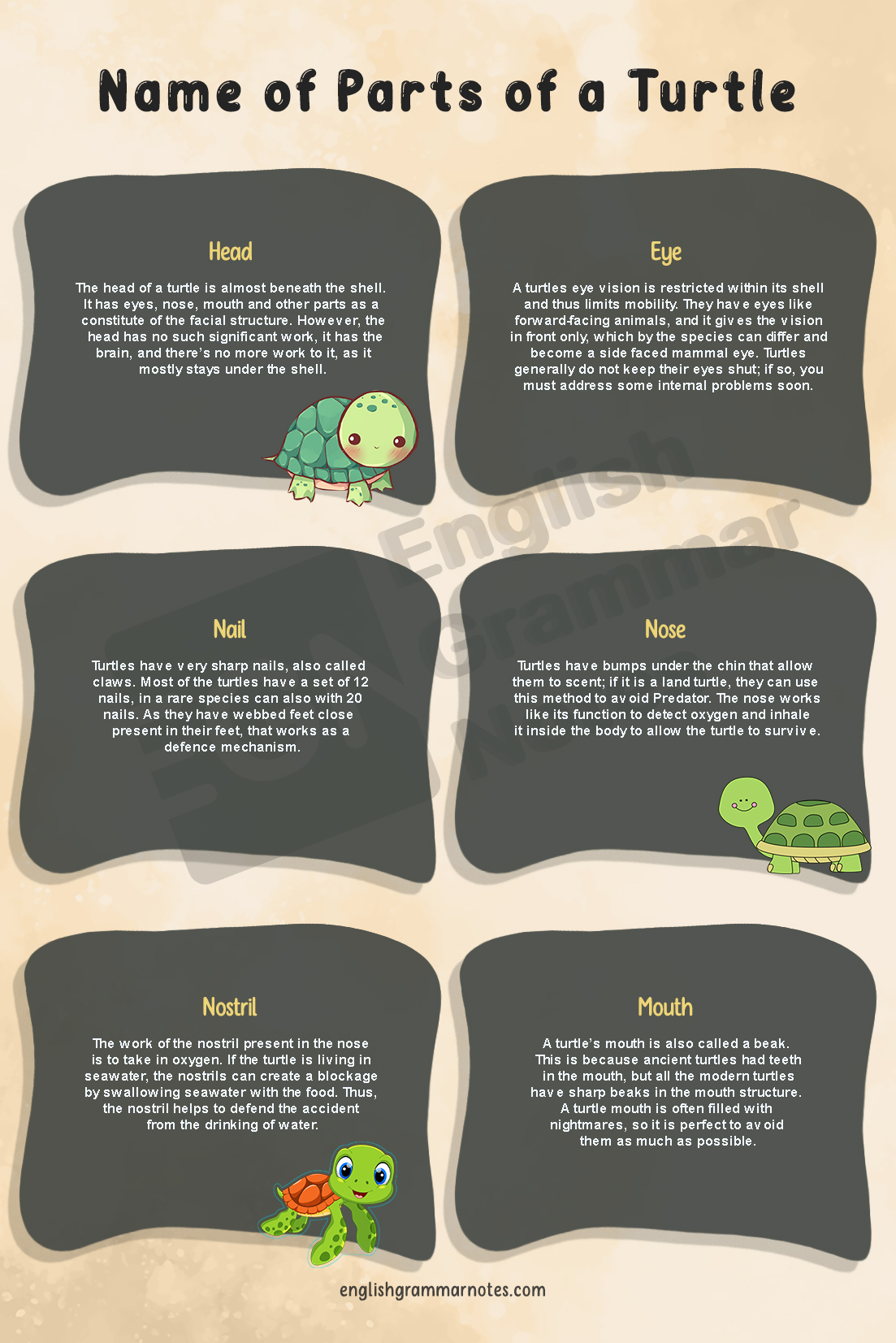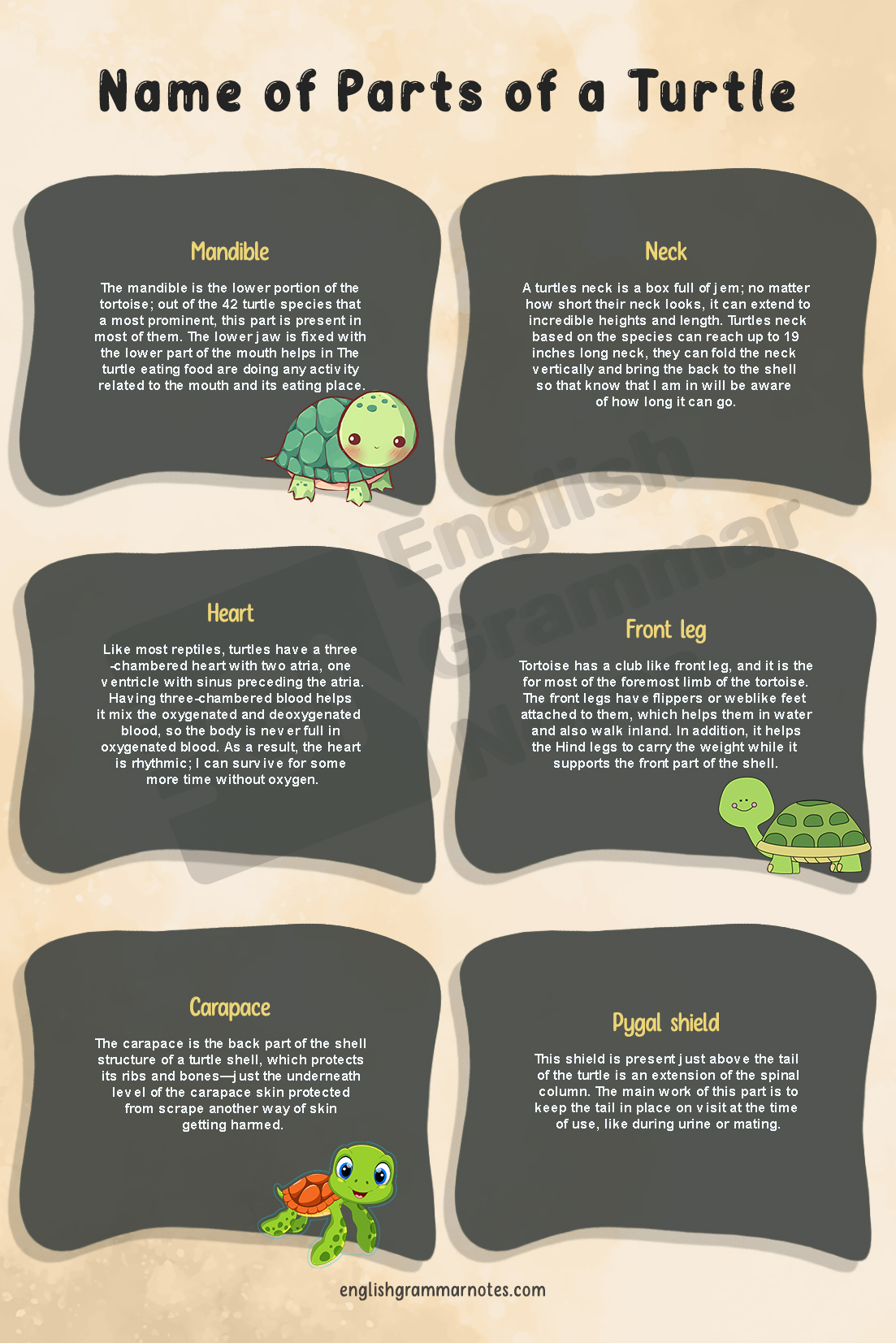Parts of a Turtle: Other than dogs and cats, small turtle animals are very popular pets for their distinctive features and qualities. If you come across a turtle pet parent or yourself who want to own one, then you should know about the turtle body parts and functions. Knowing about all the different types of turtles and where do turtles live is the basic start of your knowledge.
Turtles can very comfortably live in water and land, and unlike tortoises, their habitat is not suitable to survive in every climate. In addition, they have a unique body definition and is one of the slowest moving animals.
There are two types of species definition based on their neck structure, but this blog is aimed to confine with the parts of turtles.
Study the most important English Vocabulary Words identified by our experts and learn the right vocabulary to use in your day to day conversations
To let you expand your knowledge in this blog, we have taken a few names and made a list of parts of the turtle. So let’s get into the blog and enlarge your vocabulary.
List of Parts of a Turtle
Name of Parts of a Turtle
- Head
- Eye
- Nail
- Nose
- Nostril
- Mouth
- Mandible
- Neck
- Heart
- Front leg
- Tail
- Carapace
- Plastron
- Pygal shield
- Marginal shield
- Hind leg
- Costal shell
- Vertebral shell
Description of Parts of a Turtle on the list
Head
The head of a turtle is almost beneath the shell. It has eyes, nose, mouth and other parts as a constitute of the facial structure. However, the head has no such significant work, it has the brain, and there’s no more work to it, as it mostly stays under the shell.
Eye
A turtles eye vision is restricted within its shell and thus limits mobility. They have eyes like forward-facing animals, and it gives the vision in front only, which by the species can differ and become a side faced mammal eye. Turtles generally do not keep their eyes shut; if so, you must address some internal problems soon.
Nail
Turtles have very sharp nails, also called claws. Most of the turtles have a set of 12 nails, in a rare species can also with 20 nails. As they have webbed feet close present in their feet, that works as a defence mechanism.
Nose
Turtles have bumps under the chin that allow them to scent; if it is a land turtle, they can use this method to avoid Predator. The nose works like its function to detect oxygen and inhale it inside the body to allow the turtle to survive.
Nostril
The work of the nostril present in the nose is to take in oxygen. If the turtle is living in seawater, the nostrils can create a blockage by swallowing seawater with the food. Thus, the nostril helps to defend the accident from the drinking of water.
Mouth
A turtle’s mouth is also called a beak. This is because ancient turtles had teeth in the mouth, but all the modern turtles have sharp beaks in the mouth structure. A turtle mouth is often filled with nightmares, so it is perfect to avoid them as much as possible.

Mandible
The mandible is the lower portion of the tortoise; out of the 42 turtle species that a most prominent, this part is present in most of them. The lower jaw is fixed with the lower part of the mouth helps in The turtle eating food are doing any activity related to the mouth and its eating place.
Neck
A turtles neck is a box full of jem; no matter how short their neck looks, it can extend to incredible heights and length. Turtles neck based on the species can reach up to 19 inches long neck, they can fold the neck vertically and bring the back to the shell so that know that I am in will be aware of how long it can go.
Heart
Like most reptiles, turtles have a three-chambered heart with two atria, one ventricle with sinus preceding the atria. Having three-chambered blood helps it mix the oxygenated and deoxygenated blood, so the body is never full in oxygenated blood. As a result, the heart is rhythmic; I can survive for some more time without oxygen.
Front leg
Tortoise has a club like front leg, and it is the for most of the foremost limb of the tortoise. The front legs have flippers or weblike feet attached to them, which helps them in water and also walk inland. In addition, it helps the Hind legs to carry the weight while it supports the front part of the shell.
Tail
The three turtles contain openings from the digestive gland that can pass their urine outside and part of the reproductive tract. Distance winter is a very crucial role for the production males tend to have a longer tail than the females. There is no other friendly gesture of the tail, like wagging tail like a dog in happiness.
Carapace
The carapace is the back part of the shell structure of a turtle shell, which protects its ribs and bones—just the underneath level of the carapace skin protected from scrape another way of skin getting harmed.
Plastron
The plastron of a turtle is the flat part of the shell structure of the turtle, and this part can also be called the daily order vein structure of this shell that includes all the internal functions. The main work is to join the sides of the body, retreating a skeleton box comparison of cartilage and bones.
Pygal shield
This shield is present just above the tail of the turtle is an extension of the spinal column. The main work of this part is to keep the tail in place on visit at the time of use, like during urine or mating.

Marginal shield
At the age of the turtle shell, 12 pairs of marginal scutes comprise the shield. These small scales are set in a row on the shield area.
Hind leg
Their Hind legs are elephantine, which is capable of carrying strong and heavyweights. The tortoises potty are often very heavy, so the Hind legs word primary to carry them, also it needs the body to move water is here without problems.
Costal shell
The carapace protects the body; the internal links containing the ribs and vertebrae are called a turtle’s coastal shall area.
Vertebral shell
The major function of the vertebral shell or the column is to protect the spinal cord structure in most turtles. Revolutionizing the exoskeleton became hard; this part of the shield started to grow to protect the bony structure.